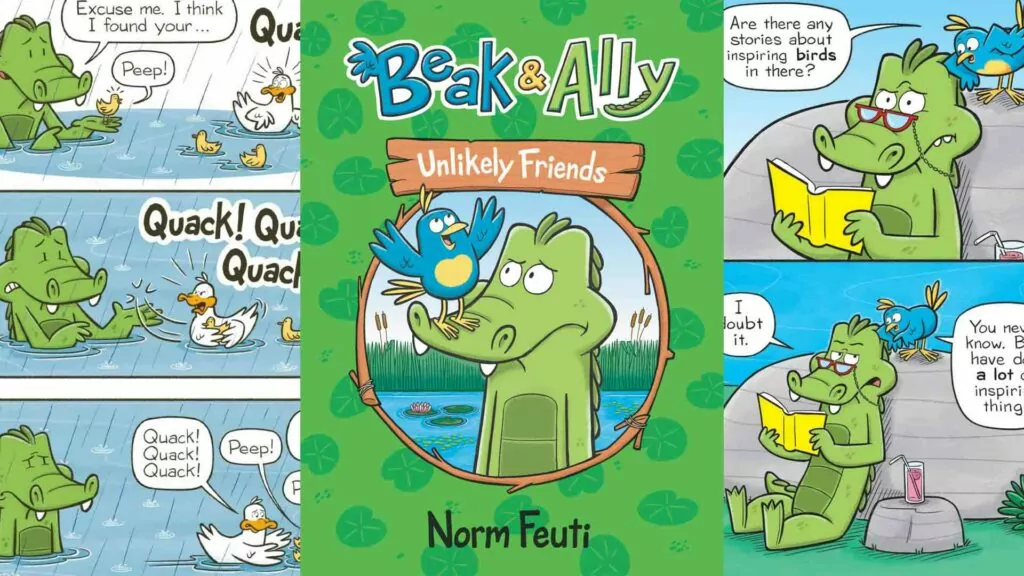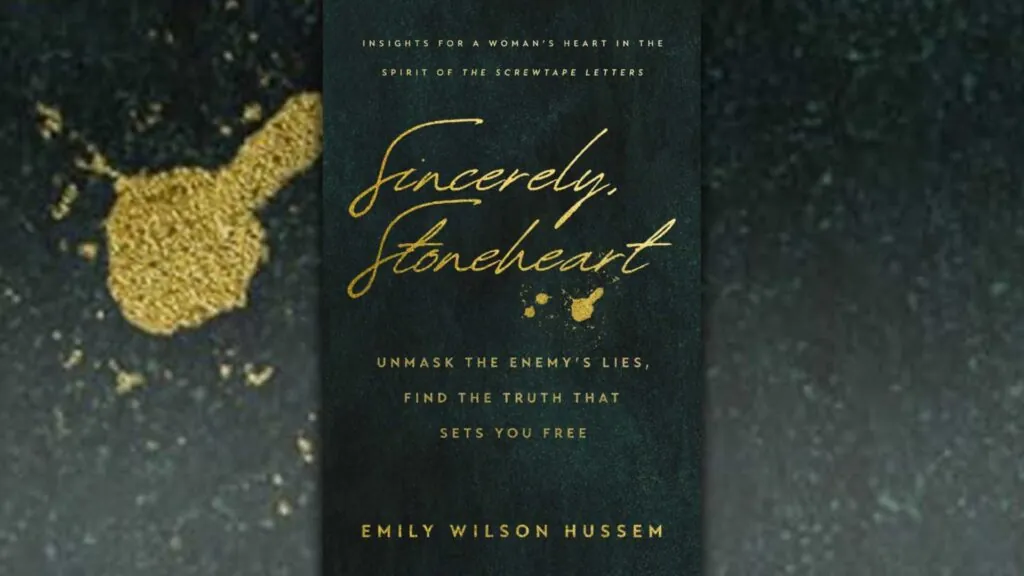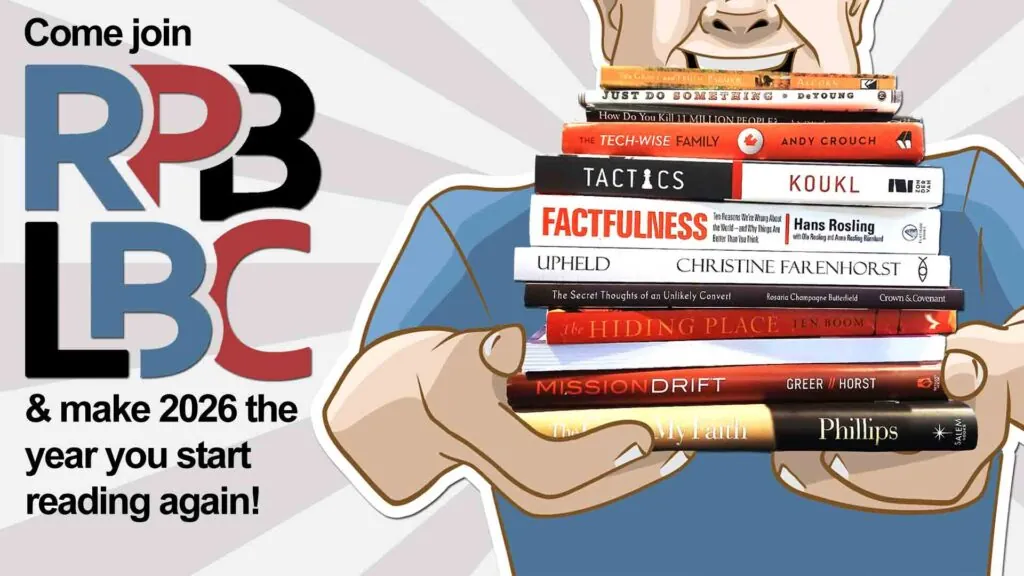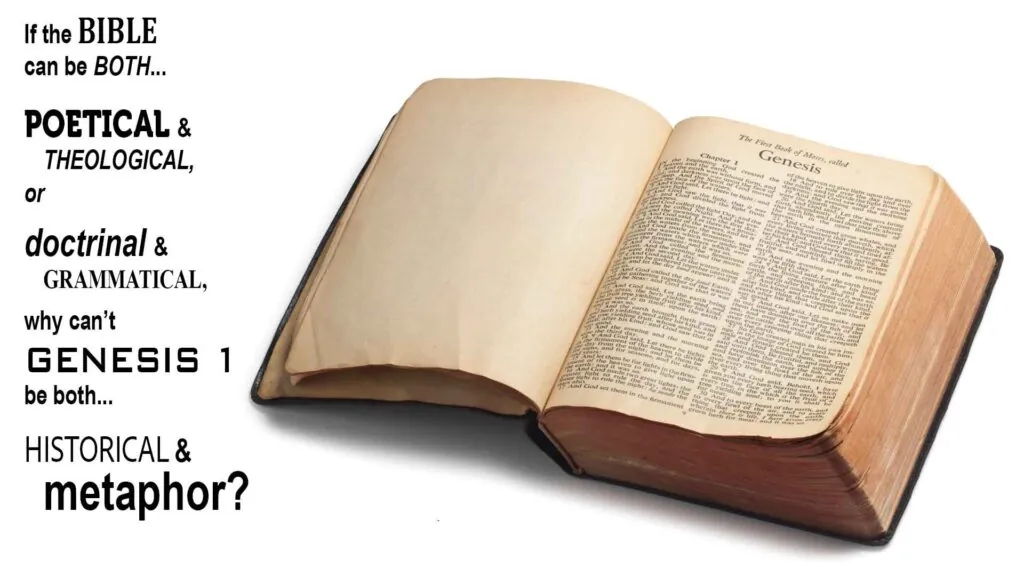TOON Books don’t have much in common with each other besides their younger target audience. As the story is told, the founding publisher, Françoise Mouly, was looking for good readers for her own son and found that what was available was boring. She was already a comic publisher, so she decided to start publishing an imprint of comic books aimed at children ages 4 through 9 to help them learn to read.
Based on some of the titles she’s published for adults, there’d be no reason to think Mouly is Christian or her selection of children’s titles would be “safe” for our kids. But a lot of them are, simply because the target demographic is so young. I think even the world recognizes that children this young should be protected, or maybe Mouly is simply bowing to market forces. Still, these are not all worth reading – the single biggest problem would probably be bratiness – the “hero” of too many of these stories isn’t all that admirable. But when they are good, they are quite good.
What follows are the bulk of TOON Book comics organized into three categories:
- Recommended
- Take It or Leave It
- Don’t Bother
Recommended (18)
These could all be solid additions to a school library. I’ve ordered them roughly from best to more middling.
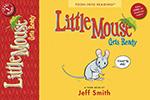 Little Mouse gets ready
Little Mouse gets ready
by Jeff Smith
2009 / 32 pages
When mom calls on Little Mouse to get ready to go, he struggles to quickly put on socks, underwar, shirt, pants, and shoes, only to have his surprised mother declare, “Why Little Mouse! What are you doing? Mice don’t wear clothes!” A silly bit of fun for Grade 1.
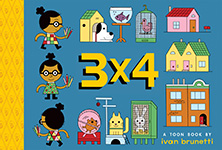 3×4 (2)
3×4 (2)
by Ivan Brunetti
2018 / 38 pages
The class is assigned a task of drawing 12 things, but in sets. That could be 2 sets of 6, or 4 sets of 3, or even, as the book title puts it, 3 sets of 4 – it is up to the students. As the students go home, they all talk about what they will draw and in how many sets. This is quite the creative way to introduce this early math concept. He also has an equally clever one about compound words called Wordplay, where a girl pictures a housefly as a flying house, and a mailman as a man made out of mail, and so on.
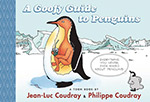 A goofy guide to penguins
A goofy guide to penguins
by Jean-Luc Coudray & Philippe Coudray
2016 / 36 pages
This is page after page of fascinating facts – and a few of them might even be true! – all about penguins. Children can turn here to find out why penguins don’t grow flowers, and why they need diving boards. For kids who want just the facts, pages in the back note nuggets like this: the deepest recorded dive for a penguin is 1,853 feet, and a male Emperor Penguin egg-sit for an average of 64 days, all the while without eating. This is quite the quietly charming title.
 Wildflowers (3)
Wildflowers (3)
by Liniers
2021 / 40 pages
We’re taken into the imaginative world of three girls exploring the island their plane has crash landed on, which is inhabited by a dragon, talking flowers, and a miniature gorilla. Only at the end do we see things as they really are – this being the forest behind their house.
This is just one of the three comics the author has based on his three daughters. The Big Wet Balloon is about a big sister showing her toddler little sister the delights of the rain. The third, Good Night, Planet might sound like something with a climate change agenda but is instead about a girl’s stuffed bunny, named Planet, and what she gets up to when the little girl is asleep.
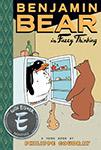 Benjamin Bear in Fuzzy Thinking (3)
Benjamin Bear in Fuzzy Thinking (3)
by Philippe Coudray
2011 / 30 pages
A bear and his friends have a series of one-page adventures. It feels a lot like what you get in the daily newspaper comics, but with a few more panels to explore and set up the gag. These are just fluff, but gentle fluff.
Two sequels, Benjamin Bear in Bright Ideas (2013) and Benjamin Bear in Brain Storms! (2015) continue the fun. If you look up the author you’ll discover he also has a series of “Bigby Bear” comics that look remarkably similar. That’s because they are similar, two different companies translating his French comics and giving the bear two different names. The notable difference is that the larger Bigby collections have occasional references to evolution while the Benjanim collections do not.
 We dig worms! (4)
We dig worms! (4)
by Kevin McCloskey
2015 / 30 pages
This is as boy a book as you’ll find – a book about all sorts of worms, from small to one that is ten feet long (and there’s even a bit on the gummy sort).
We learn that worms have no eyes or nose, and that they have cold blood. We learn they do important work, eating, leaves and bugs and bringing air to plant roots. We even get a peak inside worms and see they have 5 hearts! And there are oodles of other facts about worms. It’s a book any little boy would find fascinating all the way up through Grade 2.
This is a part of author Kevin McCloskey’s “Giggle and Learn” series, and three others worth getting include Something’s Fishy, Caterpillars: What Will I Be When I Get to Be Me? and Ants Don’t Wear Pants. But not everything in this series is worth getting – see the “Don’t Bother” category down below.
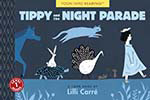 Tippy and the Night Parade
Tippy and the Night Parade
by Lilli Carré
2014 / 32 pages
This is a nice one for girls. The story begins with Tippy’s room in a big mess. Her mom wants to know how it happened, but there’s a problem: even Tippy doesn’t know. There’s a snake under the bed, a pig in the sheets, a turtle on the carpet, and bats flying overhead. How’d they all get there?
Tippy and mom get to tidying up, and Tippy heads to bed, still wondering how her room got so messy. That’s when we see how it happened – Tippy, it seems, is a sleepwalker, and so off she goes, on a trip through the woods, picking up friends here and there, before they all head back and she tucks herself back into bed with a zoo’s worth of animals to keep her company. It is a quiet little story, that might be perfect as a bed time story to girls from 3 to 8.
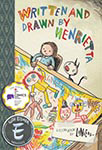 Written and Drawn by Henrietta
Written and Drawn by Henrietta
by Liniers
2015 / 60 pages
This one is a bit scary, but quite imaginative too – Henrietta is a little girl with a new box of colored pencils, and she has decided to create her own comic adventure… about “The Monster with Three Heads and Two Hats.” The funnest part is that she doesn’t know how the story is going to end, and so has to draw quickly to find out!
 A trip to the bottom of the world
A trip to the bottom of the world
by Frank Viva
2012 / 36 pages
A mouse and his human friend make a trip to the Antarctic and the little mouse would rather go home. But his boy first wants to see some sights like waves, and penguins, and whales. This is only middling as far as story and artwork, but it is safe and an accessible read for Grade 1. A companion title, A Trip to the Top of the Volcano, is also gentle and approachable.
Take it or leave it (9)
These aren’t the sort you’d ever buy, but if your local library has them, you might want to borrow them once. I’ve also ordered these by preference, with the ones higher up better than the ones lower down.
Adele in Sand Land
by Claude Ponti
2017 / 44 pages
Little Adele’s mother takes her to the playground sandbox where Adele has an imaginative, and quite bizarre, adventure. This might have made the recommended list if some of the creatures Adele meets weren’t so ugly – they aren’t so much scary as weird, and I suspect off-putting for some kids.
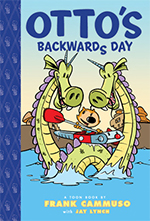 Otto’s Backwards Day (2)
Otto’s Backwards Day (2)
by Frank Cammuso
2013 / 28 pages
This is a clever story about palindromes – words that are the same backwards as forwards, like the name “Otto.” It’s also about a little self-absorbed boy named Otto, who thinks birthdays are all about the presents (and who cares about the people!?). In other words, this bratty little boy has it all backwards!
When Otto is told by his Dad that he has it all backwards, he ends up in a backwards world, where everything is “topsy turvy.” It’s fun to visit a world where you get in trouble for picking up trash, and where Otto has to ask the Ogopogo’s three questions and if he gets them right Otto will face his wrath. It’s all mixed up, with backward spelling, and a robot friend who can turn into just about anything, so long as it is a palindrome…like a “kayak” or a “race car.” By the end, Otto learns his lesson and realizes that the best part of any birthday is the people you get to spend it with.
There is an instance of “pottyesque” humor – in the backward world everyone wears their underpants on the outside, so Otto has to as well. There is nothing immodest about it – only silly in a way that might not be the sort of thing we want to encourage among some more rambunctious boys.
Otto has another adventure, in Otto’s Orange Day. It’s fun too, but features a genie, and I don’t quite know what I think of genies – an all powerful, supernatural being – for this preschool to Grade One level. Hmmm…what do you figure? Otto uses his wish to turn everything his favorite color, orange. He likes the orange world at first, but it turns out orange lamb chops are not that good, and when he wants to change things back he realizes there is a problem: the genie only gave him one wish!
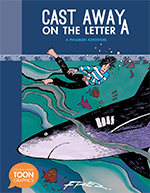 Cast Away on the Letter A
Cast Away on the Letter A
by Frédéric Othon Aristidès
2013 / 48 pages
When you look at a world map, and then focus in on the waters between Europe and the Americas you’ll find the words “Atlantic Ocean” there somewhere in big and bold letters. What if those weren’t just letters? What if, in some crazy mixed up alternate but parallel Earth, those were actually letter-shaped islands in the middle of the ocean?
That there is the premise of this little story. Philemon, a French farm boy, falls into a well, and the currents in the well sweep him past fish and sharks and , and eventually deposit him on the sandy shores of the first letter A in the “Atlantic.”
That is a crazy beginning, and as you might imagine, this is a crazy island, with two suns, and exploding clocks that grow out of the ground, and a centaur butler. Philemon eventually finds another human on the island, Bartholomew the well digger, who fell through a well he was digging and end up stranded on the island, looking for a way back for the last 40 years.
This is surreal, crazy, Alice-in-Wonderland, type of fun. And as you might expect from a story that takes place on the A in Atlantic, there are lots of surreal jokes throughout, like full-size ship in a bottle sailing through these waters.
The only caution is a minor one – a few characters express anger using made up curse symbols like these: “#@?!!” Philemon’s father, who is only a minor character is this first story, is an ill-tempered sort, and makes use of these symbols a few times.
Two more of Philemon’s tales, The Wild Piano, and The Suspended Castle, have also been translated from the original French. They are even stranger, and the stories take seemingly random turns – they border on being nonsense. I like a little absurdity every now and again, and so quite enjoyed the first, but the next two were simply too weird for me.
Jack and the Box
by Art Spigelmen
2008 / 32 pages
A little boy bunny named Jack, gets a Jack-in-the-box – or rather a Zack-in-the-box – toy from his parents, and the two become zany friends. Kind of fun, but very short.
Luke on the Loose
by Harry Bliss
2009 / 32 pages
A frenetic little kid runs after a flock of pigeons all over the city as his dad, and the police, try to find him again. Might not be the greatest example for kids (see many more of those below) but that Luke is on a leash in the last frame is dramatic enough every kid will understand this is behavior to laugh at, not imitate.
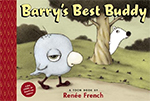 Barry’s Best Buddy
Barry’s Best Buddy
by Renée French
2012 / 36 pages
A bird’s pushy friend gets him out of the house on his birthday only to take him on a circular route right back to his house. But while they were away, ants have painted his house as a wonderful surprise! An ugly style of art, and the pushiness of the friend, are why this is here and not among the recommended.
Don’t bother
There are quite a lot of TOON Books – too many for me to highlight all of the ones that weren’t recommended. But I figured I’d share the titles of a the dozen or so I thought might be good, but which ended up not cutting it. Brattiness is the main concern with most of the books below. Kids’ stories can have bratty characters, so long as the young reader is shown that this is the wrong behavior – the brat either has to reform his ways by story’s end, or his behavior has to be denounced in some form or fashion. In what follows the brat is generally somewhat repentant by the final page, but the proportion of name-calling to niceness is tipped way too much in the wrong direction, leaving young readers with all sorts of examples of how to be creatively nasty, and just a brief illustration of how to do better. So, not the sort of story our kids need to chow down on.
Some of Kevin McCloskey’s “Giggle and Learn” series is recommended above and Snails Are Just My Speed! would’ve been included if it didn’t touch on how “snails shoot arrows at each other before they make babies.” Kids will be left mystified as to what that means, and equally mystified adults are not going to want to answer questions about baby-making to the Grade 1 age group this is intended for. Another title in this series, The Real Poop on Pigeons, is just too poopy.
Geoffrey Hayes has a series of books and I don’t like any of them. In Benny and Penny in Just Pretend, Benny and Penny in the Big No-No, Benny and Penning in Lights Out, and Benny and Penny and the Toy Breaker, Benny is a jerk to his sister for much of the book. Benny and Penny in How to Say Goodbye is supposed to teach children how to deal with death, but does so with brattiness once again, and without God. Hayes also has a second series that hits the right notes more often but brattiness pops up in Partick Eats His Peas, and little Patrick gets naked outdoors in Patrick and a Teddy Bear’s Picnic.
In Silly Lilly in What Shall I Be Today, one of the things Lilly decides to be is a vampire, and the sequel, Silly Lilly and the Four Seasons, is simply boring.
Zik and Wikki in Something Ate My Homework uses the word “bugger” in reference to a pesky fly, but as the term is more commonly used for “sodomite” this isn’t a term our kids need to learn right now. A sequel, Zikki and Wikki in the The Cow, is fixated on poop, and doesn’t entirely make sense if you haven’t read the original.
Nina in That Makes Me Mad is about a bratty girl justifying her brattiness. Meanswhile Mo and Jo: Fighting Together Forever puts a super spin on sibling brattiness, and in Maya Makes a Mess, a rude girl presumes to teach her parents manners.
Finally, Ape and Armadillo Take Over the World is about two friends plotting to do as the title suggests – more dumb than bad. And Chick & Chickie Play All Day! is simply boring.








